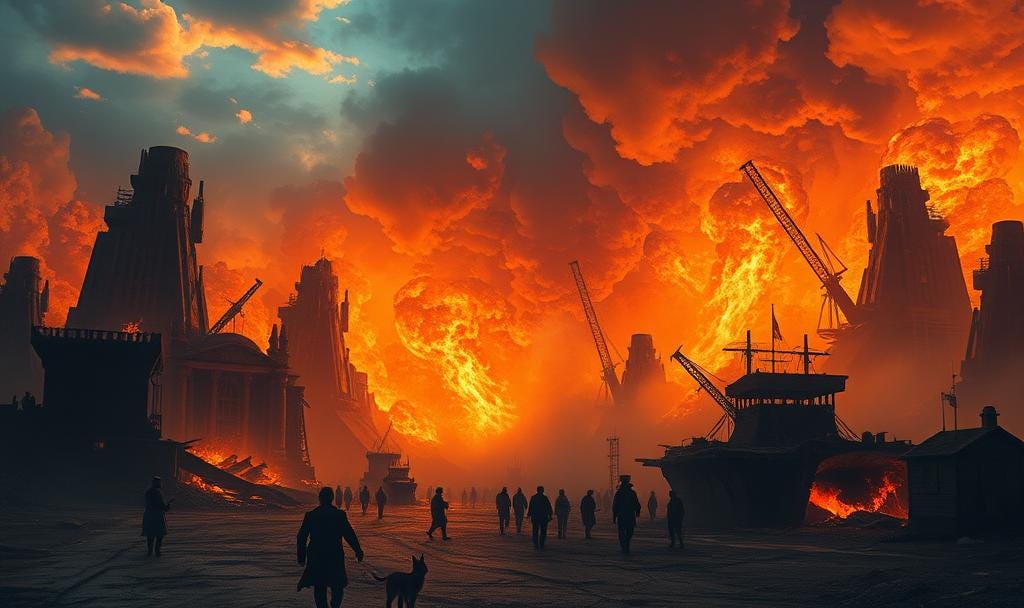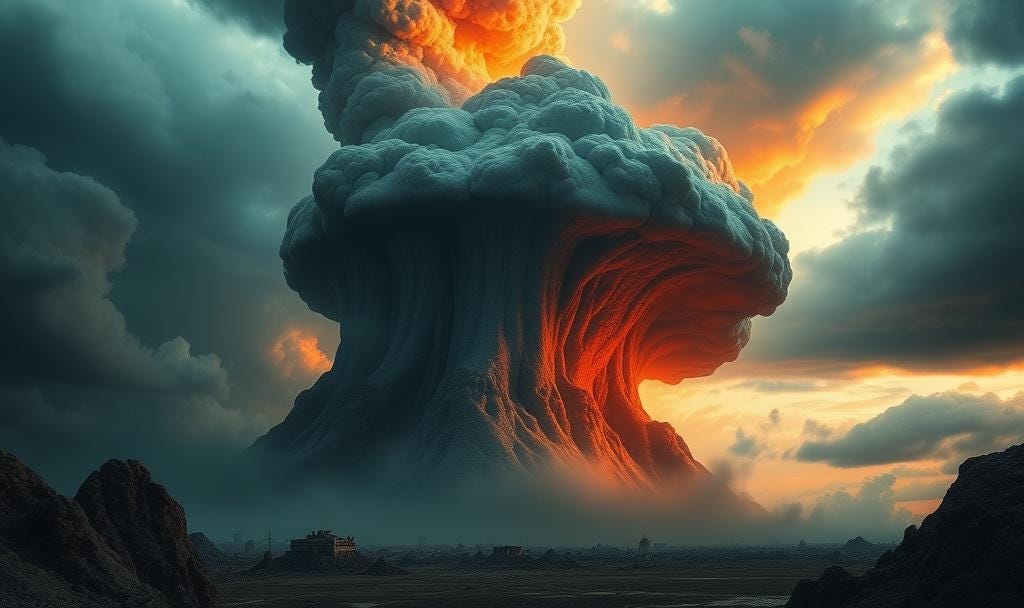The Courage to Be (Left Behind)
or, An Exvangelical Meditation on Doom, Deliverance, and Other Childhood Fears
Remember the rapture panic?
Sometime after the Satanic Panic but before the Genderfluid-Bathroom Panic—somewhere between the Moral Majority Panic and the Weapons of Mass Destruction Panic—there was Rapture Panic.
And no, it’s not a metaphor.
This was a full-scale, Kirk-Cameron-endorsed global freak-out about the end of the world. It came with a full B-rated movie script about how it would all go down. A theology that felt more Marvel comics than Book of Matthew. One moment your friends vanish mid-prayer; the next, you're left holding their nicely folded VeggieTales t-shirts and WWJD bracelets, wondering which of your sins tipped the scales and got you all Left Behind.
Then, naturally, came the resistance arc. You, a teenager, drafted into a guerrilla movement of morally ambiguous child actors, fighting the Antichrist, dodging microchips, surviving off communion wafers and end-time adrenaline. Learning that love, apparently, meant abandonment in the apocalypse. Heck… Mr. T might even show up to pity the fool who didn’t accept Jesus before Y2K.
And we believed it.
That belief got into your bones. It colonized your imagination. And it didn’t just make you afraid of the world—it made you afraid of yourself. Your body was too fleshly, too temptable, too dangerous. You learned early on that embodiment was risky, desire was suspect, and trust in your own voice was practically a one-way ticket to eternal damnation.
What does that do to a person?
It hollows you out. It replaces curiosity with control. It teaches you to flinch at tenderness, to brace for love, to second-guess joy. You end up living in a body you don’t quite trust, in a world you suspect will betray you, among people you’re quietly certain might disappear if you don’t pray hard enough.
At some point, Kirk Cameron stopped driving the bus. And something worse took the wheel.
Not a child actor. Not even an adult. But a kind of monster—some shadowy fusion of fear, shame, and self-loathing. A three-headed driver with trembling hands and a stash of old altar call brochures. And for the record, I’d bet good money they’re wearing a red trucker hat with some white letters on it.
They didn’t just steer you off-course. They whispered in your ear while they did it.
They told you not to trust your body. Not to trust your joy. Not to stay too long in anything that felt like home, because home was for the raptured, and you were still here.
And now?
Now it actually kind of looks like doomsday. Not the rapture kind—no supernatural disappearances, no horses on fire—but the slow-roasting, algorithm-saturated, oceans-rising version. The one with fascist flirtations, mass extinction, and enough collective anxiety to make even the most enlightened among us reach for the panic button.
Now the red-hatted monster doesn’t just whisper discouragement. It proclaims dominance. It parades as if it’s the only one in control. It hypnotizes the masses to follow blindly, offering shame and fear as cheap replacements for courage and hope. Fear becomes fuel. Cruelty gets packaged as conviction.
If there were a scroll to be opened, it’d probably say something like: "And lo, the sea levels rose, and the billionaires fled to Mars, and the people did doomscroll until their souls thinned out like overstretched sourdough."
The reality is…
We’ve already been raptured.
We’ve been raptured by fear and by shame and by the digital clouds.
What we need now is to be left behind.
To stay.
To remain grounded in this body, in this world.
In fact, we need the courage to be left behind.
Because as poet Ross Gay reminds us, joy isn’t the opposite of despair—it’s what grows stubbornly beside it, sometimes in the form of a tomato, sometimes in the act of holding hands even when everything’s on fire.
Paul Tillich called it “the courage to be.” Not the courage to win, or fix, or dominate—but the courage to exist meaningfully, vulnerably, awake.
Thomas Merton wrote that the “deepest level of communication is not communication, but communion.” And that communion begins with the self you were told not to trust. The self you were trained to fear. The one the monster said was too messy, too soft, too unsaved.
But that self? That’s the altar. That’s the island in the inward sea that Howard Thurman spoke of. The one guarded by the angel with the flaming sword. The sword isn’t there to punish you. It’s there to keep the world’s lies out long enough for you to hear yourself think again.
Evelyn Underhill reminded us that mysticism isn’t some floaty escape into the clouds, but a deeper way of loving what’s right here. And right here, in this very moment, maybe the bravest thing we can do is show up.
Show up in our bodies, in our flawed communities, in our relationships, in our grief.
Not to fix it all. But to say, I’m still here. I wasn’t raptured. I wasn’t erased. I’m still here and maybe that’s the most sacred thing I can say.
Even Bede Griffiths, that wild old monk blending Christian, Hindu, and contemplative worlds, said,
“We are not saved from the world, but through it.”
And Dōgen, bless him, drops in with a koan just when we need him:
“Enlightenment is intimacy with all things.”
Not escape. Intimacy.
Even with despair. Even with compost. Even with your old fears whispering from the passenger seat, while you, trembling and real, gently take the wheel.
Maybe you don’t throw the red hat out the window just yet. Maybe you pluck it off the monster’s head, put a little basil in it, and use it to start your garden.
So.
As we think about our faith deconstruction—as we reckon with the fallout of weaponized theology and end-times anxiety, as we look around at real-world devastation, political absurdity, and a planet in peril, as we stare down disorder and confront what sure feels like an evil world order
maybe we finally stop letting fear drive.
Maybe we take the wheel back.
Maybe we replace those old shame-laced, self-hating images with something better.
Not a perfect belief system. Not a new doctrine. Not certainty wrapped in a cooler aesthetic.
But something alive.
Courage. Hope. And not just deconstruction—but transformation.
The kind of transformation that doesn’t ignore collapse, but composts it. That doesn’t bypass despair, but walks with it: barefoot, gentle, and unafraid to feel.
And maybe that’s the invitation, not to escape the world, but to stay with it. To sit in the ruins of rapture stories and still plant something. Brian McLaren calls it life after doom—not because the doom didn’t come, but because it did, and we’re still here. Not raptured, not rescued, not erased. Just breathing. Choosing to love what remains. Choosing, even now, to be. That, too, is a kind of resurrection.
The kind of resurrection that dares to say:
I’m still here.
I’m not perfect.
But I’m real.
And I’m still planting tomatoes.
—
*If this sparked anything, a memory, a feeling, a question, let me know. Or just tap the ❤️ so I know you’re out there, too.





This is a beautiful call to be present and hopeful.
There are too many good lines here to comment on them all, beginning with the title itself, but this one's among my faves: "And lo, the sea levels rose, and the billionaires fled to Mars, and the people did doomscroll until their souls thinned out like overstretched sourdough." Thanks for all this Daniel. Also, P.S. for the Dogen quote.